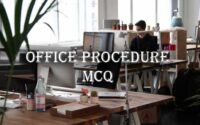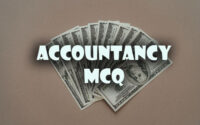Important Questions on Accountancy
1. In accounts recording is made of:
A. Only financial transactions
B. Financial as well as non—financial transactions
C. Only non—financial transactions
D. Details of personal transactions of the proprietor.
2. Of the following, who is not an external user of accounting information?
A. Investors
B. Officers
C. Banks
D. Government
3. IF Accounting information is based on facts and it is verifiable by document, it has the quality of:
A. Relevance
B. Reliability
C. Understandability
D. Comparatability
4. Which of the following is the most relevant accounting information for taxation authorities?
A. All the cash balances in the firm
B. Book value of all fixed assets
C. Profit generated during the year
D. Cash and credit sales of the year.
5. Current liability does no includes:
A. Bill Payable
B. Outstanding expenses
C. Debentures
D. Creditors
6. Which of the following is not a limitation of accounting?
A. Based on accounting convention
B. Evidence in legal matters
C. Incomplete information
D. Omission of Qualitative information
7. “Trial Balance is the list of debit and credit balances taken out from ledger, it also includes balances of cash and bank from cash book”, it was said by:
A. Pickles
B. Spicer and Peglar
C. Carter
D. Kohler
8. Which of the following is not a sub field of accounting?
A. Financial Accounting
B. Book-keeping
C. Management accounting
D. Cost Accounting
9. Trade Discount is allowed at the time of:
A. Receiving the first payment
B. Sale of Goods
C. Sale of Goods and receiving payment
D. Receiving the Goods.
10. The person who is to receive an amount from the firm, is known as
A. Debtor
B. Creditor
C. Owner
D. Promoter
11. Out of the following assets which one is not an intangible asset?
A. Patent
B. Investment
C. Goodwill
D. Trademark
12. Paid to Kamal on behalf of Anjali Rs 12,000, will be debited to
A. kamal A/C
B. Sajai A/C
C. Transfer A/C
D. Cash A/Cs
13. Goods sold for cash Rs 25,000 plus 4% VAT sales account will be credited by:
A. Rs.24,000/-
B. Rs.25,000/-
C. Rs.26,000/-
D. Rs.27,000/-
14. Total assets in a business is Rs 8,00,000/-. The Total liabilities are Rs 5,00,000/-. The Difference is known as
A. Capital
B. Total Income
C. Total Expense
D. Goodwill
15. Which of the following account has a debit balance?
A. Income received in advance
B. Bank Loan
C. Prepaid Insurance
D. Creditor for goods
16. A credit balance of a personal Account is:
A. Income earned
B. Amount receivable
C. Amount Payable
D. Balance of Cash at bank
17. Which of the following is known as ‘Principal book of Account”?
A. Ledger Book
B. Journal
C. Balance Sheet
D. Books of original entries
18. The difference of trial balance is transferred to:
A. Capital Account
B. Profit and loss account
C. Balance sheet
D. Suspense account
19. Which of the following is not a fundamental accounting assumption:
A. Going concern
B. Consistency
C. Accrual
D. Materiality
20. Accrual concept is based on:
A. Matching principle
B. Dual aspect principle
C. Cost principle
D. Going concern concept
21. Closing stock can be shown in the trial balance if
A. It is added to the opening stock
B. It is deducted from sales
C. It is shown as an asset in the trial balance
D. Deducted from purchase and shown as an asset in the trial balance.
22. Find out gross profit for the following:
Cost of Goods sold: Rs 1,00,000/-,
Gross Profit of 20% on sales.
A. Rs 25,000/-
B. Rs 20.000/-
C. Rs 10,000/-
D. 24,000/-
23. “Salaries and wages” appearing in the trial balance is shown:
A. Trading Account Debit side
B. Profit and loss account debit side
C. Asset side-Balance sheet
D. Outstanding Liabilities balance sheet.
24. Cost of goods sold=Rs. 1,50,000/-,
Closing stock: Rs 40,000/-,
Opening stock=Rs. 60,000/-.
Then, the amount of purchase will be:
A. Rs. 1,30,000/-
B. Rs 1,70,000/-
C. Rs 50,000/-
D. Rs. 1,00,000/-
25. Gross sales Rs 9,05,000, sales return=Rs 5000. G.P is 20% on cost. The Gross profit will be:
A. Rs 2,00,000/-
B. Rs 1,50,000/-
C. Rs 1,80,000/-
D. Rs 1,81,000/-
26. What will be the cost of Goods sold? Net sales= Rs 2,85,000/-, Gross Profit = 25% on sales
A. Rs. 210750
B. Rs. 213750
C. Rs. 71250
D. Rs. 1,42,500
27. The purpose of preparing Final Account is to
A. Profit and loss Account
B. Capital employed
C. Value of assets utilised
D. Profit or loss and financial position
28. Which one of the following is not a current asset?
A. Prepaid expense
B. Sundry Debtors
C. Copy right
D. Stock
29. A manager will get 10% commission of the net profit, Rs 22000 remaining after charging his commission. The Commission will be:
A. Rs 2200
B. Rs 2000
C. Rs 1980
D. Rs 1500
30. “Commission earned but not received-Rs 3000″. The adjustment entry will be:
A. Accrued Commission A/C—Dr Rs 3000 to Commission Received A/C— Rs 3000
B. Commission Earned A/C — Dr Rs 3000 to Commission Received A/C— Rs 3000
C. Commission receivable A/C Dr Rs 3000 to Commission A/C Rs 3000
D. Cash A/C — Dr Rs 3000, to Commission receivable A/C Rs 3000
31. Profit before the following adjustments is Rs 80,000/- outstanding expenses Rs 10,000, Prepaid insurance = Rs 13,000. The profit after adjustment will be:
A. Rs. 83,000/-
B. Rs 77,000/-
C. Rs 1,03,000/-
D. Rs 87,000/-
32. Operating profit earned: Rs 170000/— Non-Operating Income: Rs.15000/- Non-Operating expense: Rs 37,500/— What is the amount of Net Profit?
A. Rs 1,92,500/-
B. Rs 1,55,000/-
C. Rs 1,47,500/-
D. Rs 1,85,000/-
33. Which one of the following is not a Capital Expenditure?
A. Extension of a room
B. Carrying change of a machine
C. White Washing of a building
D. Construction of seats of a Cinema Hall
34. If the debit and credit aspects of a transaction are recorded in the cashbook, it is called:
A. Compound Entry
B. Closing Entry
C. Adjustment Entry
D. Contra Entry
35. Which account will be debited in the books of acceptor at the time of discharge of a bill?
A. Bill payable account
B. Cash account
C. Drawer’s Account
D. Endorsees’ Account.
36. Calculate Net Sales:
Cost of Goods Sold: Rs 4,50,000,
Gross profit: 25% on sales
A. Rs. 540000
B. Rs. 550000
C. Rs. 600000
D. Rs. 650000
37. Adjustment entry for: “Prepaid Insurance Amounted to Rs 5000/- will be:
A. Insurance Account Dr Rs 5000 To Prepaid Insurance — Rs 5000
B. Prepaid Insurance Dr 5000 To Insurance Payable —Rs 5000
C. Prepaid Insurance Dr 5000 To Insurance Account Rs 5000
D. Insurance Account Dr Rs 5000 To Cash Account —Rs 5000.
38. Closing stock is shown in the financial statement at:
A. Cost Price
B. Market Price
C. Cost Price or realisable value whichever is higher.
D. Cost price or market price whichever is lower.
39. Heavy amount spent for advertisement of a new product is:
A. Revenue expenditure
B. Capital expenditure
C. Deferred Revenue expenditure
D. Capitalised revenue expenditure.
40. Profit after Commission is Rs. 94, before Commission is Rs. 100, Profit after Commission is Rs 470000, then profit before Commission will be:
A. Rs 5,00,000
B. Rs 5,20,000
C. Rs 6,00,000
D. Rs 7,20,000
41. Goods sold at M.P=Rs20000,
T.D. is 10%,
C.D. is 5%.
The Amount to be paid on the day is:
A. Rs. 18,000/-
B. Rs.17,100/-
C. Rs 19,000/-
D. Rs. 17,000]-
42. Charged Interest on Drawings of the proprietor Rs.250. What will be the Correct Entry?
A. Interest on Drawings A/C Dr R5250 To Drawing A/C-Rs.250
B. Cash A/C Dr – – Rs 250 To Interest on Drawings A/C— Rs 250.
C. Drawing A/C Dr – – – Rs 250 To Interest on Drawings A/C—Rs 250
D. Interest on drawings A/C Dr Rs 250 To Cash A/C – – – Rs 250.
43. A firm shows
C.P. Rs 12000,
N.L. Rs 28000.
Depreciation during the year: Rs 2000.
Calculate Indirect expenses debited on P.L. A/C:
A. Rs 39,000/-
B. Rs 38,000/-
C. Rs 40,000/-
D. Rs 42,000/-
44. A Court declares Raju insolvent for a sum of Rs 25,000/-Only 65 paise could have been collected per Re. Show how much amount be debited in Bad Debt Account:
A. Rs. 16,250/-
B. Rs. 8,750/-
C. Rs. 8,125/-
D. Rs. 11,250/-
45. Under which accounting concept provision is made for doubtful debts?
A. Consistency Concept
B. Money measurement concepts
C. Principle of conservatism
D. Cost Principle
46. Cost of obtaining licence to carry out a business is to be included in:
A. Capital Expenditure
B. Revenue Expenditure
C. Deferred Revenue Expenditure
D. Capitalised Revenue Expenditure
47. Given: Debtors- Rs 80,000/-, Bad Debts — Rs 6,000/-, Provision for doubtful Debts — Rs 7,000/-. Further it is desired to make new provision for doubtful debts at 10% on debtor. How much is to be debited to profit and loss A/C?
A. Rs 8,000/-
B. Rs 10,000/-
C. Rs 13,000/-
D. Rs 7,000/-
48. If a bill is accepted and the payment is made before the due date of maturity, the difference between the paid amount and bill amount will be called as:
A. Interest
B. Discount
C. Debate
D. Commission.
49. Biren draws a 40 days bill on Rohan on 20th January, 2010. The Bill matures on
A. March 4, 2010
B. February 28, 2010
C. March 1, 2010
D. March 3, 2010
50. On 13-07-2009, A draws a bill on B for Rs 25,000/- for 30 days. The due date of the bill will be:
A. 15th August, 2009
B. 14th August, 2009
C. 17th August, 2009
D. 16th August,2009



